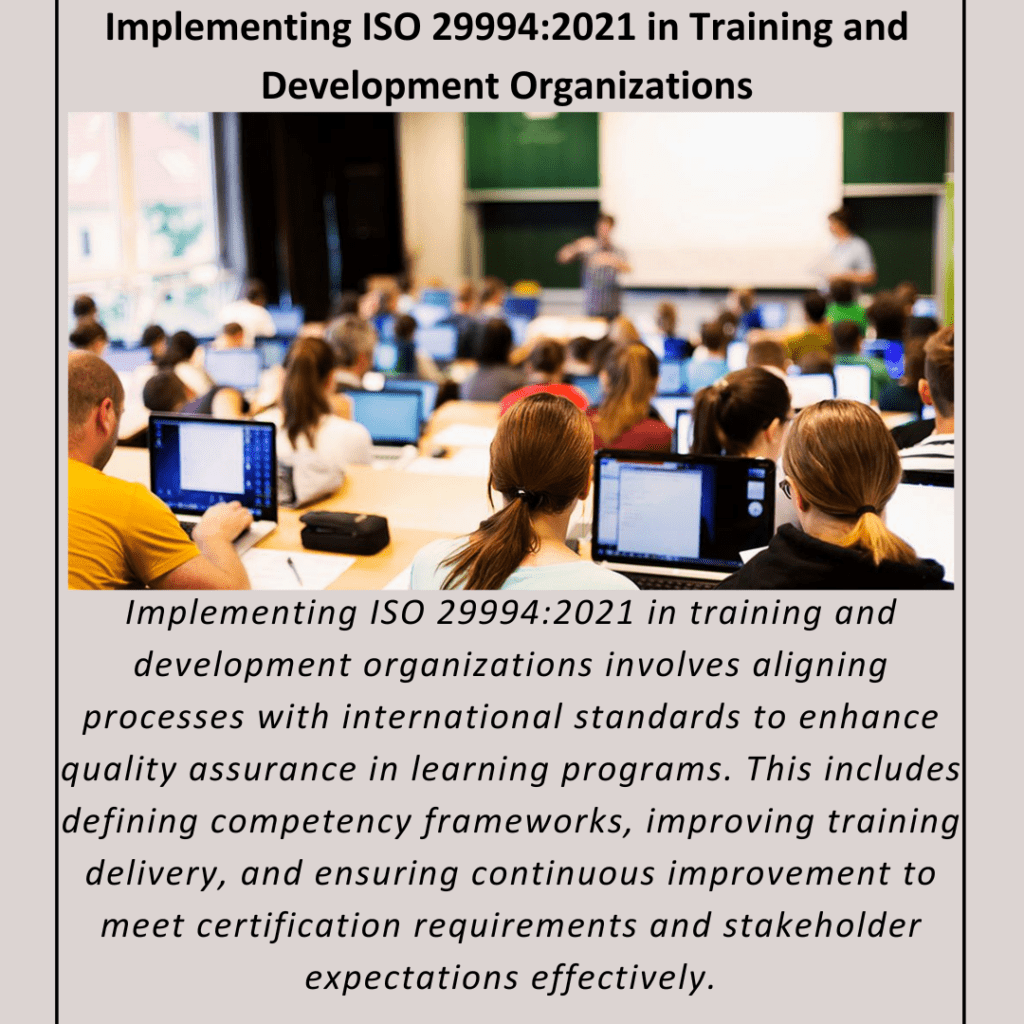Subtotal $0.00

ISO 29994:2021 sets forth international guidelines for learning service providers, aiming to enhance the quality and effectiveness of training and development programs. For organizations seeking to adopt this standard, understanding its requirements and effectively implementing them is crucial to achieving certification and reaping its benefits.
Understanding ISO 29994:2021
ISO 29994:2021 specifies requirements for learning service providers, emphasizing the need for consistent delivery of high-quality learning services. It builds upon principles of quality management systems (QMS) and focuses specifically on the unique aspects of educational services, including:
Management Commitment: Top management must demonstrate leadership and commitment to the implementation of the standard by establishing policies, objectives, and processes that align with ISO 29994:2021 requirements.
Competence of Personnel: Ensuring that personnel involved in delivering training services possess the necessary qualifications, skills, and experience to fulfill their roles effectively.
Learning Design and Delivery: Emphasizing the importance of designing and delivering learning programs that meet the specified objectives and learning outcomes, tailored to the needs of learners.
Monitoring and Evaluation: Implementing processes for monitoring the effectiveness of training programs, collecting feedback from learners and stakeholders, and using this information to improve service delivery.
Continuous Improvement: Establishing mechanisms for continual improvement, including corrective actions and preventive measures, to enhance the quality of learning services over time.
Steps to Implement ISO 29994:2021
1. Gap Analysis and Planning
The implementation process begins with a thorough gap analysis to assess current practices against ISO 29994:2021 requirements. This involves:
Identifying Stakeholders: Engaging key stakeholders across the organization, including management, trainers, and support staff.
Document Review: Reviewing existing documentation, policies, and procedures related to training and development.
Gap Identification: Identifying gaps between current practices and ISO 29994:2021 requirements.
Based on the gap analysis, an implementation plan is developed, outlining specific actions, responsibilities, and timelines for achieving compliance.
2. Establishing a Management System
Central to ISO 29994:2021 compliance is the establishment of a robust management system that integrates with existing quality management practices. This includes:
Policy Development: Developing a quality policy that aligns with ISO 29994:2021 principles and objectives.
Roles and Responsibilities: Clearly defining roles and responsibilities for personnel involved in training design, delivery, and evaluation.
Document Control: Implementing a document control system to manage policies, procedures, and other documentation required by ISO 29994:2021.
3. Competence and Training of Personnel
Ensuring the competence of personnel is critical to delivering high-quality learning services. Steps include:
Training Needs Analysis: Identifying training needs for personnel based on their roles and responsibilities.
Training Programs: Developing and implementing training programs to enhance the skills and knowledge of personnel in areas relevant to ISO 29994:2021 compliance.
Competence Evaluation: Establishing processes for evaluating the competence of personnel, including assessments and performance reviews.
4. Designing and Delivering Learning Services
Effective learning design and delivery are essential to meeting the requirements of ISO 29994:2021. Key considerations include:
Needs Assessment: Conducting needs assessments to identify the learning needs and objectives of learners.
Learning Design: Developing learning programs that are aligned with identified needs and objectives, incorporating effective instructional design principles.
Delivery Methods: Selecting appropriate delivery methods and technologies to facilitate learning, ensuring accessibility and engagement.
5. Monitoring and Evaluation
Monitoring and evaluation processes are integral to assessing the effectiveness of learning services and identifying areas for improvement:
Performance Metrics: Establishing key performance indicators (KPIs) to measure the performance of training programs and services.
Feedback Collection: Implementing mechanisms for collecting feedback from learners, trainers, and other stakeholders.
Evaluation Criteria: Developing criteria for evaluating the achievement of learning outcomes and the overall effectiveness of training services.
6. Continual Improvement
Continuous improvement is at the core of ISO 29994:2021. Organizations should:
Review and Audit: Conduct regular reviews and audits to assess the performance of the management system and compliance with ISO 29994:2021 requirements.
Corrective Actions: Implement corrective actions to address non-conformities and prevent recurrence.
Learning from Experience: Use lessons learned from monitoring, evaluation, and feedback to make informed improvements to training programs and services.
Benefits of ISO 29994:2021 Certification
Achieving ISO 29994:2021 certification demonstrates an organization’s commitment to quality and continuous improvement in learning services. Key benefits include:
Enhanced Credibility: Certification enhances credibility with clients, learners, and stakeholders by demonstrating adherence to internationally recognized standards.
Improved Efficiency: Streamlined processes and improved resource management contribute to greater efficiency in delivering learning services.
Risk Management: Systematic risk assessment and mitigation processes reduce potential risks associated with training delivery.
Market Access: Certification opens doors to new markets and opportunities where ISO 29994:2021 compliance is a requirement or a competitive advantage.
Challenges and Considerations
Implementing ISO 29994:2021 may pose challenges, such as:
Resource Allocation: Adequate resources, including time, personnel, and financial investment, are necessary for successful implementation.
Organizational Change: Implementing new processes and systems may require cultural and organizational changes that require effective change management strategies.
Integration with Other Standards: Organizations already certified to other standards (e.g., ISO 9001) must ensure integration and alignment of management systems.
Conclusion
Implementing ISO 29994:2021 in training and development organizations requires a systematic approach, commitment from leadership, and engagement of personnel at all levels. By focusing on competence development, effective learning design, and continuous improvement, organizations can enhance the quality and effectiveness of their learning services, ultimately achieving ISO 29994:2021 certification and reaping its associated benefits.